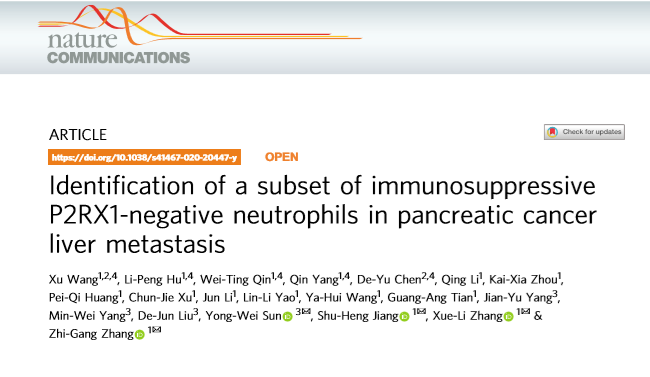
Research Progress
Zhang Zhigang team from SCI and Sun Yongwei team from Renji Hospital revealed the mechanism of formation of immunosuppressive microenvironment in pancreatic cancer with hepatic metastasis
Date:2021-01-15Pancreatic cancer has an extremely high degree of malignancy, with a median survival period of about six months, and a 5-year survival rate of around 8% [1], which is called “the king of cancers”. High invasiveness and metastasis are the major causes of the high degree of malignancy in pancreatic cancer. According to the epidemiological survey, distant metastasis is found in more than half patients with pancreatic cancer when definitely diagnosed, resulting in a 5-year survival rate of less than 4%, and the liver remains the most vulnerable to metastasis.。
Genomic testing data have shown that primary pancreatic cancer has very similar tumor mutation spectrum to pancreatic cancer with hepatic metastasis, and the driver genes of pancreatic cancer therein, including KRAS, TP53 and SMAD4, experience almost the same mutations [2]. Different from genomic sequencing results, the transcriptomic detection results indicated significant differences, especially those in the expressions of tumor microenvironment related-genes, between primary pancreatic cancer and pancreatic cancer with hepatic metastasis [3]. These suggest that the changes in the tumor microenvironment may be closely associated with the hepatic metastasis in pancreatic cancer。

A research paper titled “Identification of a subset of immunosuppressive P2RX1-negative neutrophils in pancreatic cancer liver metastasis” was jointly released online by Zhang Zhigang team from Shanghai Cancer Institute (SCI) and Sun Yongwei team from the Department of Biliary-Pancreatic Surgery, Renji Hospital Affiliated to Shanghai Jiao Tong University School of Medicine in the journal of Nature Communications on January 8, 2021. It has been well-recognized that adenosine triphosphate (ATP), as an intracellular energy currency, has diverse biological functions. In addition to serving as an energy currency, ATP also plays an important role extracellularly, which can act as a neurotransmitter or signaling molecule to respond to extracellular stress stimuli and transmit cellular signals by interacting with other receptors [4]. ATP receptors are abundantly expressed in immunocytes, and extracellular ATPs can promote immunoenhancement in dendritic cells, macrophages, neutrophils and other immunocytes [5]. A high concentration of ATP [5] is present in the tumor microenvironment, and the mechanism by which the tumor mediates immunosuppression in such a microenvironment remains elusive. It was found in the present study that hepatic metastasis in pancreatic cancer mobilized and recruited ATP receptor P2X purinoceptor 1 (P2RX1)-negative (P2RX1-) neutrophils which then highly expressed programmed death-ligand 1 (PD-L1), Arginase 1 (Arg1) and other immunosuppressive molecules to mediate the formation of immunosuppressive microenvironment in pancreatic cancer with hepatic metastasis for lack of the ATP receptor P2RX1.
In this study, the authors found through analyzing the transcriptomic data of primary tumor and hepatic metastatic tumor in pancreatic cancer that the expression of P2RX1 declined in the hepatic metastasis tumor tissues, and its expression was positively correlated with immunodepletion-related molecules and negatively associated with the expressions of anti-tumor immune response-related genes. These results imply that the decline in P2RX1 expressions may mediate the formation of immunosuppressive microenvironment in pancreatic cancer with hepatic metastasis. Subsequently, the flow cytometry results showed that the down-regulation of P2RX1 expressions in the hepatic metastasis tissues was associated with neutrophils, and P2RX1- neutrophil subsets were considerably increased in number. The P2RX1 gene knock-out mice were applied, and it was further discovered that the transcription factor nuclear factor E2-related factor 2 (Nrf2) was highly expressed in P2RX1-deficient neutrophils and mediated the expressions of immunosuppressive molecules such as PD-L1 and Arg1 in P2RX1- neutrophils. Moreover, PD-L1 and anti-PD-1 antibody substantially blocked the inhibitory effect of P2RX1- neutrophils on the CD8+ T cells that can kill tumor cells. It was first revealed through the above work that P2RX1- neutrophil subsets can modulate the formation of immunosuppressive microenvironment in pancreatic cancer with hepatic metastasis, thereby providing a novel idea and potential target for the immunotherapy of hepatic metastasis in pancreatic cancer.
Zhang Zhigang team in SCI has been devoted to research on the systematical regulation of tumor microenvironment for many years, and the previous work achievements have been published in internationally renowned journals, including the Gastroenterology, Gut, Hepatology, Journal of Hepatology, Clinical Cancer Research, and Cancer Research.
The co-first authors are Wang Xu, Hu Lipeng, Qin Weiting, and Yang Qin from Shanghai Jiao Tong University and Chen Deyu from Affiliated Hospital of Jiangsu University, and the corresponding authors are Zhang Zhigang, Zhang Xueli, Jiang Shuheng and Sun Yongwei from SCI.
The present study was funded by National Natural Science Foundation of China, Shanghai Natural Science Foundation, and Shanghai Municipal Commission of Health and Family Planning.
